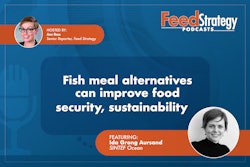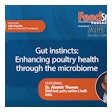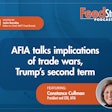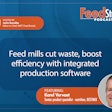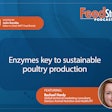
Effects of China’s plan to lower soybean content in feed (8:36)
Ann Reus: Hello and welcome to the Feed Strategy podcast. I’m your host, Feed Strategy senior reporter Ann Reus.
Today, I’m speaking with Garrett McDonald, agricultural attaché in the U.S. Department of Agriculture’s Office of Agricultural Affairs at the U.S. Embassy in Beijing. He’s here to discuss China’s plans to lower soybean content in animal feed produced there, why it is moving toward this goal, and what those aspirations might mean for international trade.
Hi, Garrett. Thanks so much for joining me on the podcast.
Garrett McDonald: Happy to be here, Ann.
Reus: China has said it wants to lower soybean content in animal feed produced in the country. What have been the recent trends on soybean use for feed in China?
McDonald: Well, you’re correct about that. And so the Ministry of Agriculture and Rural Affairs, or MARA, as we say for short, it’s certainly trying to encourage industry here to reduce soybean meal usage. So, if we look at MARA data on soybean meal inclusion rates in feed, we do see a drop in the average inclusion rates from 2021 to 2022. It goes from about 15.3% to 14.5%. But if we expand that a little bit and look over the past five years, the actual trend has been more of an up and down in the inclusion rates. I also think it’s important to note that the 14.5% rate in 2022, this was reached during a year when soybean meal prices here hit record highs and the livestock and poultry sectors as well as much of the economy in general was really struggling with the PRC’s Zero-COVID policy and lots of lockdowns. So, it’s not entirely surprising to see inclusion rates lower during this period.
Reus: And I’ll just note here, the PRC is the People’s Republic of China.
McDonald: Correct.
Reus: What is the reason for this move toward lower soybean use?
McDonald: So, the PRC has longstanding goals to increase self-sufficiency in numerous areas, including agriculture, and soybean meal inclusion is one of those areas that MARA is looking to show progress. So each year, the CCP – the Chinese Communist Party – and the State Council issue what’s known as the No. 1 Document, which is sort of a high-level policy paper that offers guidance on development goals in China’s agricultural sector. So, in line with this document, last April, the Ministry of Agriculture issued a three-year plan to reduce or substitute soybean meal in feed. And its goal was to reduce soybean meal by half a percentage point per year. So, from 14.5% in 2022, down to about 13% in 2025.
Reus: Is this goal achievable by using alternative ingredients? And what ingredients are they using as alternatives?
McDonald: So, for any given period, industry can adjust feed rations that might result in lower rates of soybean meal inclusion. This might include anything from greater use of amino acids to swapping out other meals such as peanut meal, cottonseed meal, or greater use of rice bran and wheat in the in the rations here. You know, a feed ration is a balance sheet. So there are many ways that you can adjust the various inputs. But the reality is that, in terms of having a consistent availability and quality, there really is no equal alternative to the protein component that is provided by soybean meal. So it’s, I think, also important to remember that China’s not a major soybean meal importer. China imports soybeans and crushes them because they need both the meal and the oil. And so, as a result, over time, China has built up a massive crushing capacity. I think our numbers put it somewhere around 145 million metric tons. So there’s actually also here a real interest in continuing to crush and utilize these investments.
Reus: What are some other concerns or challenges around the use of alternative ingredients?
McDonald: Well, I can’t really speak to any of the nutritional challenges or concerns, but I do know from industry contacts that, on the procurement side and the plant management side, the folks I speak to certainly face challenges in procuring these alternatives. So, many times, these are purchased in relatively small volumes – a container here or a truckload there – and it requires adjusting their feed ration matrix to bring them in as inputs. So it’s extremely taxing for the team at the mill to constantly be hunting for these as alternatives, and from the experience over the last couple years they might get lucky one week and find, for example, like sunflower seed meal at a good price that they can substitute with, buying it on the spot market. But the chances are that when they go back to buy more, the prices have increased or the supply just isn’t there. So, again, I think a lot of the inclusion question in the feed is really going back always to the pricing and availability.
Reus: So, MARA has issued guidelines on lowering the use of soybean meal, but are there specific policies or regulations around it, or around increasing production of alternative ingredients?
McDonald: Yeah, so MARA has issued a plan, but it is not a directive or a regulation that requires certain targets or goals be met. It’s more of an aspirational roadmap for the feed sector. And we do see policies, as it relates to increasing production, certainly of soybeans. And they are doing this primarily through various types of subsidies implemented at different levels of the government. As a result, we do believe that there has been a shift in the past two years to more soybean planted area. But, it’s important to note that the vast majority of domestically produced soybeans do not compete with imported soybeans. Domestic soybeans are typically consumed for food use. And, while imports do not predominantly enter the food use channel, those go for a crushing for oil and feed. So, with higher domestic production, we do expect to see some of the local beans entering crushing channels since the production, as it increases, is exceeding food consumption by several million tons. But the extent to which that occurs is likely depending on the price gap. And, regardless, we’re not talking about significant volumes in the context of China’s overall demand.
Reus: Will this shift in soybean use have implications for international trade?
McDonald: When I talk to industry contacts here, the sense that I get is that much of the reductions, efficiencies and substitutions that are being promoted in this plan have largely been adopted to some degree. So, the livestock, poultry, aquaculture sectors in China, they’re highly competitive. And companies are always trying and always looking to find ways to trim costs. So, most companies have already scoured their supply chains to squeeze out efficiencies. Now, certainly, if we were to see soybean meal prices spike again, as they did in 2022, that could lead to lower inclusion rates and lower imports, which could lead some to think that perhaps this plan is hitting its targets. But our assessment continues to be that the plan itself will have minimal long-term impact on soybean demand. And, to the extent that industry adopts on top of what it’s already practicing, it’s likely to be more as a tool to provide producers with more flexibility when they see higher soybean meal prices and not really as a permanent replacement for soybean meal in feed.
Reus: All right. Well, thank you so much, Garrett, for talking with me today.
McDonald: Thanks for having me, Ann, my pleasure.
Reus: And thank you to the audience for listening. I’m Ann Reus for Feed Strategy.

